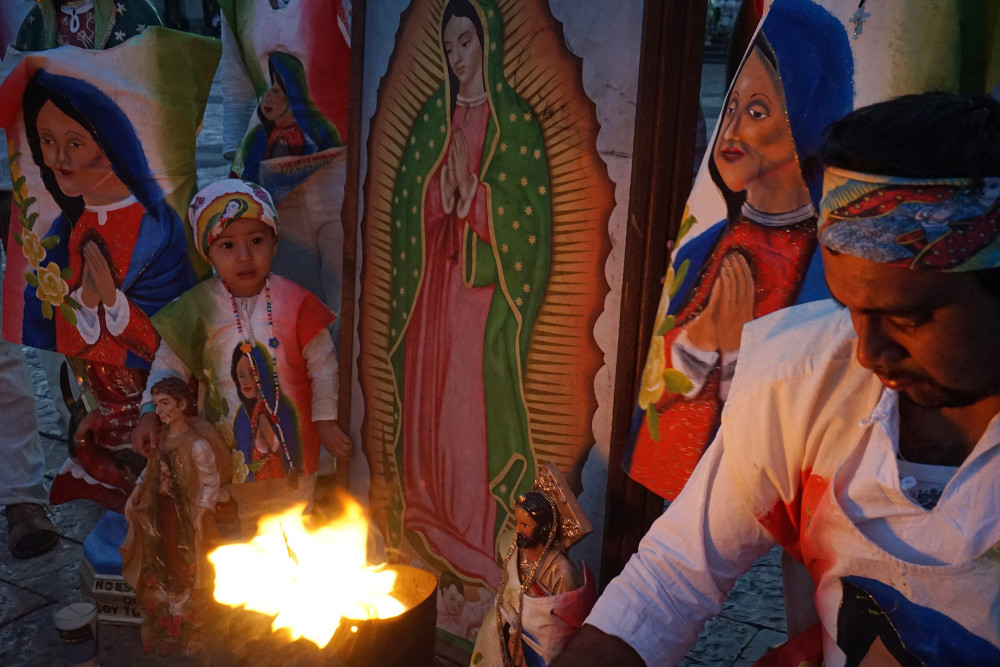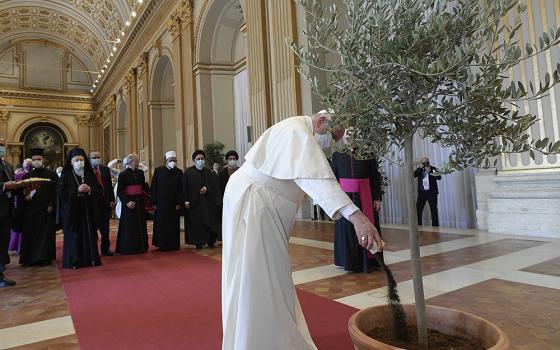
A Chiapas family visits the Basilica of Guadalupe to bless the youngest daughter in Dec. 2018, in Mexico. (RNS/Irving Cabrera Torres)
In the year 1531, an indigenous Mexican peasant named Juan Diego Cuauhtlatoatzin climbed Tepeyac hill, near what is now Mexico City. There, he had a series of apparitions of the Virgin Mary, who appeared to him not as the porcelain-skinned, blonde, blue-robed figure familiar from many church statues, but as a visibly pregnant, brown-skinned teenage girl, speaking not in Spanish, the language of missionaries and conquerors, but in Juan Diego’s native Nahuatl.
And according to him, her first words to the terrified young man were this: “Am I not here, who am your mother?”
The recent resurgence of interest in Mary and proliferation of images of her in popular culture can be traced to moments like these, when she appears unexpectedly, often to marginalized people in challenging situations. In many cases, those people testify that like the Virgin of Guadalupe encountered by Juan Diego, Mary offered them protection in moments of danger.
She has become a mother figure to millions, many of them non-Christians, and in these difficult days, many who have lost their mothers, who are struggling mothers themselves, or those who cannot be with their mothers are turning to Mary for consolation and support.
But it’s important to understand that the Mary we meet on Mother’s Day in 2020 is not the same Palestinian Jewish girl who gave birth to Jesus 2,000 years ago.
Nor is Mary a sentimentally perfect woman, meek, mild and passive, a religious Hallmark card who has come to represent the idealized mother figure most of our own mothers would struggle to measure up to.
In Elizabeth Johnson’s book on Mary, "Truly Our Sister," she writes that this version of Mary “functions paradoxically to disparage all other women,” and since the hierarchy of the Catholic Church has long taught that no woman can be as pure and obedient as Mary, all other women can therefore be seen as sinful temptresses. This idea still lingers in the church today, as evidenced by the priest who was trashed on Twitter last year when he told women to cover their shoulders in church, not for their own sake, but to protect the purity of men.
Johnson has a very different view of Mary, reframing her as a radical visionary who sees a more equitable world as God’s desire for humanity.
During the pregnant Mary’s visit to her older but also pregnant cousin Elizabeth, Mary sings the Magnificat, which Johnson describes as “the prayer of a poor woman.” In the Magnificat, Mary speaks of a world where God raises the lowly and sends the rich away, where the social order is upended and the poor and vulnerable are the most beloved. Mary, being young and female and living under the oppressive rule of the Roman Empire, is chosen by God because she is unconventional and inconsequential.
And she sings this song not to an audience of powerful men but to another pregnant woman.
This radical Mary is the one many women meet today, a fierce mother for our challenging times. Johnson recounts a group of Filipino women saying that the Mary they understood was “a strong woman” and that they were reclaiming and redefining Mary as a liberator of all people.
Similarly, black, Asian and Latinx women have reimagined Mary in all manner of ways. In the paintings of Yolanda Lopez, Guadalupe is portrayed in three eras of her life: as a young woman running with a smile on her face, as a woman in midlife sewing a tilma at a sewing machine, and as an elderly woman in glasses, holding the shed skin of the serpent the young Guadelupe is portrayed as stomping on.
Even in older depictions of Mary, instead of the simplistic idea of a perfect, pious Mary, we meet frowning Mary, scholarly Mary, joyful Mary and Mary crowned as a queen. These images traveled around the world along with Christianity and enabled people whose native religions were oppressed to adapt Mary in the image of their own indigenous goddess figures, meaning Mary is globalized but also localized, a symbol of the conquering religion subversively reinvented by the conquered.
Because we never learn what happened to Joseph, who vanishes before Jesus arrives in Jerusalem, this also means Mary has special meaning for widows and single mothers. And even for those who struggle with infertility or those who never became biological mothers, or for the nurses, teachers, therapists and others who do the often poorly remunerated work of caretaking, Mary becomes a symbol of the value of women’s work in our society, so often overlooked and so rarely praised.
More recently, there have been stories on social media about apparitions of Guadalupe appearing to immigrants stranded at the border, a phenomenon that goes back to the '90s, when Robert Orsi wrote that Mary would appear in the middle of the night and distract the border guards, thus allowing immigrants to slip by undetected.
And Pope Francis, who has emphasized immigration as one of the most pressing justice issues of our time, has a special veneration to a version of Mary known as the Undoer of Knots, a liberating Mary who can free us from the kinks and tangles of injustice and confusion.
For those of us whose mothers worked in often thankless jobs, whose mothers stood in line at food banks, whose mothers struggled and fought with difficult husbands, and whose mothers spoke up about injustices large and small, Mary is a reminder that the least likely person is sometimes the one who will wind up changing the world, even if that world is just the world of the family we grew up in.
But on this Mother’s Day, as we watch mothers and women yet again shoulder the burdens of a world in crisis, Mary is not a bad figure to turn to, because like any good mother, she, too, shoulders the world.
(Kaya Oakes is the author of four books, most recently including The Nones Are Alright. Her fifth book, on faith and feminism, will be released in 2021. She teaches writing at UC Berkeley. The views expressed in this commentary do not necessarily reflect those of Religion News Service.)
Advertisement




